Tamiya 1/48 Lancaster B.III (Special) “Grand Slam”
Little needs to be said about the Lancaster, one of the truly legendary “greats” of the Second World War. A product of brilliant improvisation when the twin-engine Manchester proved underpowered and unreliable, Avro took the airplane and provided a wing extension to allow four Merlins for powerplant. The Lancaster became the backbone of Bomber Command and proved itself to have a back that couldn't be broken as it carried bomb loads no other bomber of the war came close to.
Prolific aviation genius Sir Barnes Wallis, chief designer at Vickers-Armstrong, first conceived the idea of an “earthquake bomb” before the war. He calculated that if a bomb of sufficient size were dropped from an altitude of approximately 40,000 feet, and was aerodynamically designed to spin as it fell, that it could penetrate the ground deeply enough to create an “earthquake” effect that would destroy nearly any target. He also made a preliminary design of a bomber capable of such a feat, but it was well beyond the existing technological state of the art, and the Air Ministry paid no heed to his presentation in 1939.
Following the success of Wallis' “bouncing bomb” against the Ruhr dams in the famous “Dambuster raid,” more attention was paid to Wallis' ideas, as he modified his ideas to allow a contemporary aircraft to carry them. The first result was the 12,000-pound “Tallboy” bomb which could be carried by a Lancaster. Dropped from 20,000 feet, it would make a crater 80 feet deep and 100 feet across and could penetrate 16 feet of concrete.
On 8‑9 June, 1944 eight Lancaster bombers of 617 Squadron used the Tallboy for the first time in an attack against the Saumur Rail Tunnel. Between then and the end of the war, 854 Tall Boy bombs were used, the most note‑worthy mission resulting in the destruction of the battleship Tirpitz, which took three attacks and 77 Tall Boys dropped to finally accomplish in November 1944.
Wallis original concept had called for a bomb weighing 20,000 pounds, and he proceeded to design such a weapon beginning in July 1943, scaling up the Tallboy. Amazingly, the Lancaster could carry it, at the cost of removing all armament other than the tail turret and reducing the crew by two men. It was given the very accurate name “Grand Slam,” though it was also known as “Ten Ton Tess.” It was the largest non-atomic bomb ever used in combat and generated two-thirds the explosive force of the Hiroshima atomic bomb.
Like the Tallboy, the fins of the Grand Slam generated a stabilizing spin. The bomb had a thicker case, which allowed deeper penetration. After hot molten Torpex (“Torpedo Explosive”) was poured into the casing, it took a month to cool and set. After release from the Lancaster B.Mk 1 (Special) bomber,the Grand Slam would reach near‑supersonic speed, approaching 1,049 ft/sec, or 715 mph. When it hit, it penetrated deep underground before detonating. The resulting explosion could create a cavern and shift the ground to undermine a target's foundation.
The bomb was tested live in a drop over the New Forest on 13 March 1945. Following the success of this test, the bomb was released for combat use.
The Grand Slam was first used on 14 March 1945 when 18 Lancasters of 617 Squadron, four with Grand Slams and the rest with Tallboys, led by Squadron Leader C.C. Calder attacked the Bielefeld railway viaduct, destroying two spans.
The next day, on 15 March 1945, two Lancasters of 617 Squadron with Grand Slams and 14 from 9 Squadron with Tallboys bombed the Arnsberg railway viaduct in poor weather. One Grand Slam and 10 Tallboys were dropped, though the viaduct was not cut. Because of the low rate of production and consequent high value of each bomb, aircrews were told to land with their unused bombs on board rather than jettison them into the sea if a sortie was aborted, which was done with the Lancaster succesfully landing with the full load. Four days later on 19 March, 19 Lancasters of 617 Squadron, six with Grand Slams, the other 13 with Tallboys, attacked the railway viaduct again. All six Grand Slams were dropped and blew a 40‑foot gap in the viaduct, severely damaging the remaining standing structure.
Subsequent Grand Slam attacks, all flown by 617 Squadron, included:
On 21 March 1945, 20 Lancasters, two with Grand Slams and the other 18 with Tallboys, attacked the railway bridge at Arbergen. The Grand Slams landed off-target due to heavy flak and aiming problems. Two Tallboy hits damaged the approaches to the bridge and put it out of use. One Lancaster was lost.
On 22 March 1945, 20 Lancasters, six carrying Grand Slams, the remainder Tallboys, attacked the railway bridge at Nienburg between Bremen and Hanover. Five Grand Slams made direct hits and the bridge was completely destroyed. Five Tallboys were brought home.
The next day, 23 March 1945, 20 Lancasters, six carrying Grand Slams, the remainder Tallboys, attacked a railway bridge near Bremen. The Grand Slams appear to have
Four days later on 27 March 1945 20 Lancasters attacked the Valentin Bunker submarine pens near Hamburg, a huge, nearly‑ completed structure with a concrete roof up to 23 feet thick. Two Grand Slams penetrated parts of the pen with a 14 ft 5 inches thick roof, rendering the structure unusable.
On 9 April 194, 17 Lancasters, two with Grand Slams and the remainder with Tallboy bombs successfully attacked the U‑boat shelters in Hamburg port. The Grand Slams appear to have missed, but six Tallboy hits caused considerable damage.
The final attack was on 19 April 1945, when 20 617 Lancasters, six with Grand Slams and the remainder with Tallboy bombs, along with 16 9 Squadron Lancasters with Tallboys, attacked coastal gun‑batteries on Heligoland, putting them out of action.
After the war, the RAF and USAAF continued development of the Grand Slam as part of “Project Ruby” to investigate use of penetration bombs against heavily protected, concrete targets. The target was the Valentin submarine pens, which had been severely damaged on 27 March 1945. Grand Slams were carried by Lancasters from 15 Squadron and B‑29 Superfortresses. 140 sorties were flown, testing a range of different bombs.
Five complete Grand Slams still exist on display at museums in the UK. One T-14, the American version, is on display at the Air Force Museum.
The ASM‑A‑1 Tarzon, also known as VB‑13, mated the guidance system of the earlier Razon radio‑controlled bomb with a British Tallboy and saw brief operational service in the Korean War. The “Tarzon” name was a combination of “TAllboy, Range and aZimuth ONly,” a description of the weapon and guidance system. Used only by the 19th Bomb Group, the first combat drop took place 14 December 1950. 30 missions were flown between December 1950 and March 1951 in strikes against North Korean bridges and other hardened targets, with confirmed destruction of at least six high‑priority targets, including a hydroelectric plant.
On 29 March 1951, during a Tarzon strike against Sinuiju, the group commander's B-29 was destroyed as a result of the premature detonation of the bomb when the weapon was jettisoned in preparation for ditching.[The 30th and final mission, three weeks later, also suffered an unintentional detonation of a jettisoned, "safed" bomb, time without the loss of the aircraft. An investigation proved the fault lay in the construction of the tail; breaking up on impact, a “safed” bomb would have its arming wire removed, rendering it “unsafe” leading to detonation. Modifications were made, but the damage had been done. The safety issues, increased maintenance costs compared to conventional bombs, and the fact the guidance system required clear‑day use only which made the bombers vulnerable to enemy fighters, and the requirement that it be released at a prime altitude to be in danger from enemy flak, combined with poor reliability (only 6 of 28 bombs dropped destroyed their targets) led to cancellation of the program in August 1951.
In January 2014, an investigation was made of the site where the first Grand Slam was dropped in the New Forest. Using ground penetrating radar, magnetometry, electrical resistivity and electrical resistivity tomography, experts have been able to assess the damage done to the large concrete target building which has been buried under a vast mound of earth ever since. The bomb struck 250 feet from the target and created a crater 70 feet deep 130 feet in diameter. Observers at the time saw the building physically move when the bomb exploded.
Tamiya first released their 1/48 Lancaster in 1973, and it has been in and out of production since. The March 2013 release saw the kit parts in light grey plastic rather than the previous black, with the addition of the later tail turret with two .50 caliber machine guns as used in limited numbers during the war and by all after the war. It also included both the narrow-chord props used by the B.I and the later “paddle props” used by the B.III. There is also all three different bombardier's clear domes used during the Lancaster's service. Decals and markings inlcuded the white-over-black Lancaster B.III (FE) Lancasters that toured North America in 1948.
I already had the older “Dambuster/Grand Slam” Lancaster kit, which I had picked up at a modeler's estate sale, and decided to finally make the Grand Slam airplane, since the kit included decals for the airplane flown by Squadron Leader Calder during the first attack against the Bielefeld Viaduct.
While the parts were newly molded, the old problems of the kit had not been remedied. Putty is still needed on the fuselage centerline seam and the engine cowlings, with subsequent sanding down and rescribing of detail. Belcher Bits makes a set of resin engine cowlings for this kit that solve all the problems, and if you are going to invest in doing this, getting hold of that set is highly recommended.
I had thought of using the Eduard “Big Ed” set and really detailing the model, but I realized as I got into it that outside of the detail in the cockpit, nothing else would be visible when completed. I therefore limited myself to using the photoetch instrument panel, throttle controls, flight engineer's panel and the seatbelts for the seats that can be seen.
I assembled fuselage, wings, and horizontal stabilizers and rudders as separate assemblies that would be brought together after the model was painted. I thought about doing the post-war markings option, with the airplane painted as a day bomber, but decided I would rather have it as a combat airplane and used that markings and decal option.
I first painted the Dark Earth and Dark Green upper surface camouflage, then masked that off and painted the rest of the model with Tamiya X-18 Semi-gloss black. I then gave the model an overall coat of Future.
I used a combination of kit decals from the “Dambuster/Grand Slam” kit for the individual aircraft codes and serial, and the newer kit's national insignia, which is printed in the right colors. The thick Tamiya decals went down without problem under a blast of Solvaset.
I then assembled the various sub-assemblies. The model had been packed away in a box prior to my recent move, and when I took it out, some small parts, such as the rudder mass balance on the right side of the right rudder, and the radar antenna on the right side of the fuselage, and been knocked off and lost. Fortunately the model was headed for Planes of Fame, where it is displayed with the left side facing the viewer. I applied exhaust stains per photos, then unmasked the canopy and attached the tail turret.
The Tamiya Lancaster is still a very impressive kit. While some might complain about the raised-line panel detail, in fact this results in a more accurate-looking surface than would be the case with engraved paneling, since it looks like the real lapped panel construction. Fit is still very “1970s”, but nothing any modeler with a modicum of skill cannot deal with.
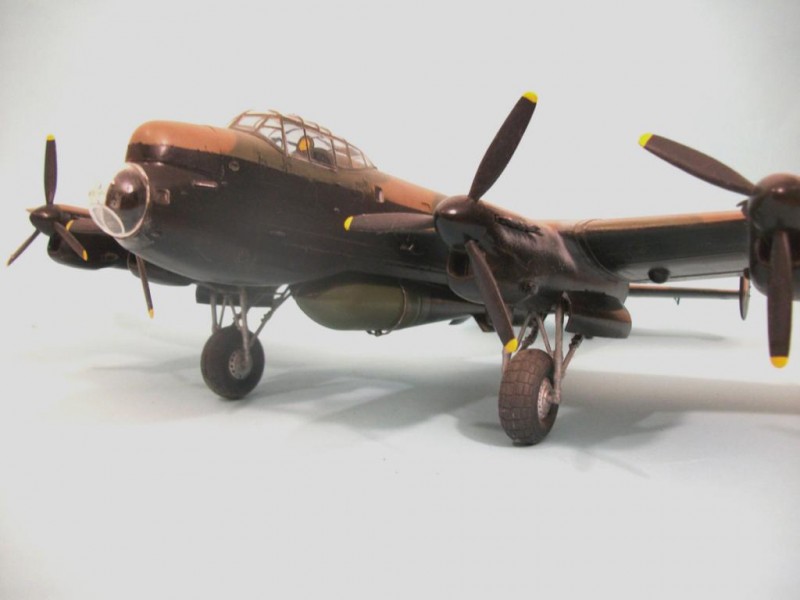
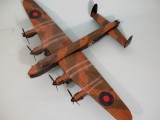

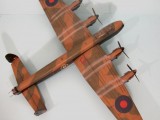

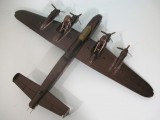
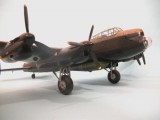
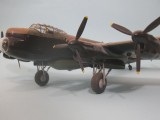
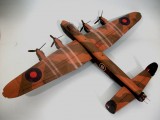

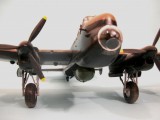
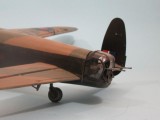
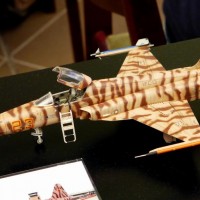
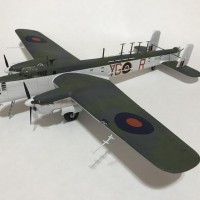
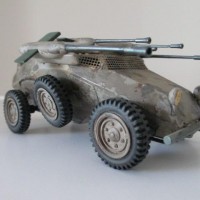
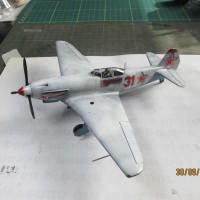
It looks GOOD Tom ! Must be a big ol' model in this scale.
🙂 ... Greetings ... 🙂 :
Nice work on the camouflage, very nice model.
A nice rendition of a true legend. The ground crew need to fix those missing wingtip lights . Well done!
Fortunately, where it is, a "tough crowd" like this here doesn't look at it. The perils of moving mid-project. 🙂
Just joking Tom. It deserves to be displayed! Well done!
Interesting article and nice model.
High impact modelling. If you ever get a chance to get to the RAF Museum at Hendon, check out their Lanc. It's only when you get up close to one that the size really hits you, and this, 75 years ago. In Lincolnshire they now have one nearly airworthy, and you can, for a price, get in and taxi up and down the runway. The money all goes to maintaining the rather expensive machine (This is not the one from the Battle of Britain flight, by the way.).
🙂 … Greetings … 🙂 :
Nice work
Nice build and nice narrative, I learn something new with every posting.
Very nice looking Lanc!
A bit of information on doing Lancs to file in the long-term memory banks for your next Lanc project (courtesy of an English modeler who really does know his subject):
Due to the dihedral on the outer wing, it turns out that the exhaust for a Lancaster only goes over the wing with the inner engines, it's all below the wing for the outers. Turns out it is the "most common Lancaster mistake" for modelers. (and if you look at any Lanc in-flight pic where you can see the uppere wing - which I did - you can see this fact very clearly).
Since I do have more Lancs in my future, this is good to know.
Nice model as well as article.Got to see one several years ago at the Gathering of Mustangs and Legends in Columbus, OH. That Lanc hailed from Canada, big plane, really big plane.
I had the opportunity to see the Canadian War Heritage Lanc fly at a local airshow. It became the "Rock Star" of the show with loud clapping and whistling anytime it took the air. Folks would crowd the ropes as it landed and taxied in... when the ropes came down it was the plane to get up close and personal. Now add having read the "Dam Busters" by James Holland...this kit is frosting on the cake.
Two thumb up.
Your Spitfires always look great.The same goes for this RAF heavy lifter.Good job.